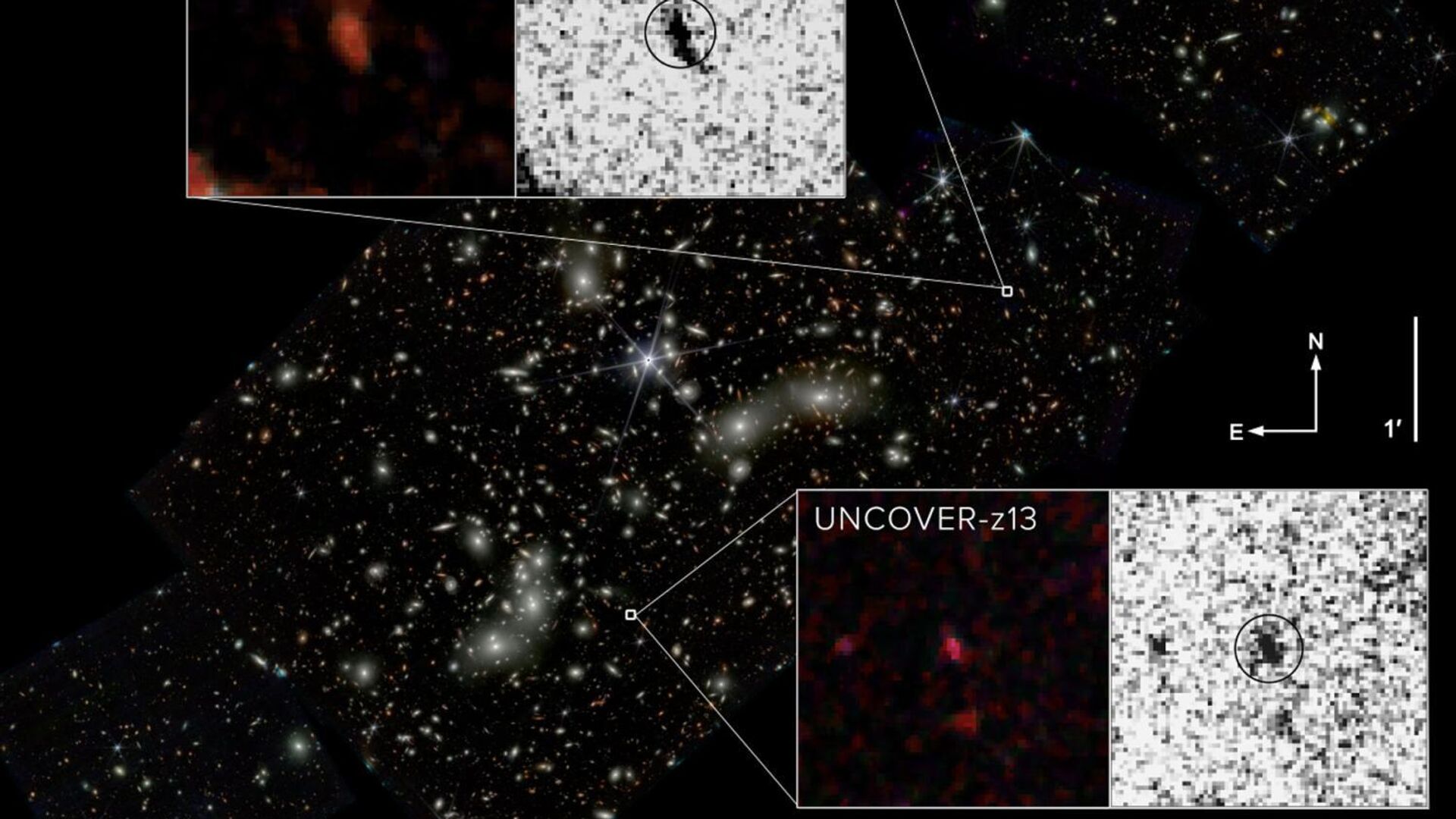https://sputnikglobe.com/20231114/webb-space-telescope-uncovers-two-most-distant-galaxies-yet-1114961596.html
Webb Space Telescope Uncovers Two Most Distant Galaxies Yet
Webb Space Telescope Uncovers Two Most Distant Galaxies Yet
Sputnik International
The James Webb Space Telescope (JWST) has identified two galaxies, UNCOVER-z13 and UNCOVER-z12, confirming these galaxies as the second and fourth most distant ever observed.
2023-11-14T22:18+0000
2023-11-14T22:18+0000
2023-11-14T22:17+0000
beyond politics
science & tech
james webb space telescope (jwst)
space
space exploration
galaxy
galaxies
https://cdn1.img.sputnikglobe.com/img/07e7/0b/0e/1114961439_0:193:1501:1037_1920x0_80_0_0_849722a975caf51cbfa541db938eddc2.jpg
The James Webb Space Telescope (JWST), renowned for its precision, has once again altered our cosmic understanding after officials were able to bring to light two galaxies: UNCOVER-z13 and UNCOVER-z12.Utilizing the gravitational lens of the galaxy cluster Abell 2744, the telescope peered into the past and confirmed these galaxies as the second and fourth-most distant ever observed.The galaxies, situated around 3.5 billion light-years away, appeared with unique characteristics, defying the typical point-like shape of galaxies at such distances. UNCOVER-z13, with a redshift of 13.079, secures its place as the second-most distant galaxy whereas UNCOVER-z12 follows closely with a redshift of 12.393.What sets these galaxies apart is their structural diversity. Unlike previously discovered galaxies at similar redshifts, the UNCOVER galaxies exhibit elongated and spherical shapes. UNCOVER-z12, in particular, boasts an edge-on disk spanning about 2,000 light-years, six times larger than its contemporaries.Despite their differences, both galaxies share key characteristics supportive of the Big Bang model. The galaxies are young, small, possess a low abundance of heavy elements, and actively form stars. These findings align with the narrative of the universe's early stages, where galaxies evolved from modest beginnings through mergers and rapid growth.While the JWST possesses the capability to detect even younger galaxies with higher redshifts, the absence of such discoveries in the lensed images raises intriguing questions. Scientists speculate on the possibilities: either galaxies did not form before the observed time, or the current observations are a result of a limited observational window.The findings were published in Astrophysical Journal Letters.
https://sputnikglobe.com/20231112/james-webb-space-telescope-boosts-ice-pebble-drift-theory---study-1114901131.html
Sputnik International
feedback@sputniknews.com
+74956456601
MIA „Rossiya Segodnya“
2023
News
en_EN
Sputnik International
feedback@sputniknews.com
+74956456601
MIA „Rossiya Segodnya“
Sputnik International
feedback@sputniknews.com
+74956456601
MIA „Rossiya Segodnya“
james webb space telescope, how old can a galaxy be, oldest galaxies, nircam, latest galaxies study, what is uncover-z13
james webb space telescope, how old can a galaxy be, oldest galaxies, nircam, latest galaxies study, what is uncover-z13
Webb Space Telescope Uncovers Two Most Distant Galaxies Yet
Recent cosmic revelations provided by the James Webb Space Telescope has offered profound insights into galaxy formation and endorses the fundamental tenets of the Big Bang theory.
The James Webb Space Telescope (JWST), renowned for its precision, has once again altered our cosmic understanding after officials were able to bring to light two galaxies: UNCOVER-z13 and UNCOVER-z12.
Utilizing the gravitational lens of the galaxy cluster Abell 2744, the telescope peered into the past and confirmed these galaxies as the second and fourth-most distant ever observed.
The galaxies, situated around 3.5 billion light-years away, appeared with unique characteristics, defying the typical point-like shape of galaxies at such distances. UNCOVER-z13, with a redshift of 13.079, secures its place as the second-most distant galaxy whereas UNCOVER-z12 follows closely with a redshift of 12.393.
"Previously discovered galaxies at these distances … appear as a dot in our images... But one of ours appears elongated, almost like a peanut, and the other looks like a fluffy ball," Bingjie Wang, part of the JWST UNCOVER team, said in a statement.
What sets these galaxies apart is their structural diversity. Unlike previously discovered galaxies at similar redshifts, the UNCOVER galaxies exhibit elongated and spherical shapes. UNCOVER-z12, in particular, boasts an edge-on disk spanning about 2,000 light-years, six times larger than its contemporaries.

12 November 2023, 13:48 GMT
Despite their differences, both galaxies share key characteristics supportive of the Big Bang model. The galaxies are young, small, possess a low abundance of heavy elements, and actively form stars. These findings align with the narrative of the universe's early stages, where galaxies evolved from modest beginnings through mergers and rapid growth.
"It makes sense that these early galaxies don’t have heavy elements like metals because they were some of the first factories to build those heavy elements... They would have to be young and star-forming to be the first galaxies, but confirming these properties is an important basic test of our models and helps confirm the whole paradigm of the Big Bang theory," said Joel Leja, who is an assistant professor of astronomy and astrophysics at Penn State University and a co-researcher on Wang’s team, said in the statement.
While the JWST possesses the capability to detect even younger galaxies with higher redshifts, the absence of such discoveries in the lensed images raises intriguing questions. Scientists speculate on the possibilities: either galaxies did not form before the observed time, or the current observations are a result of a limited observational window.
The findings were published in
Astrophysical Journal Letters.



